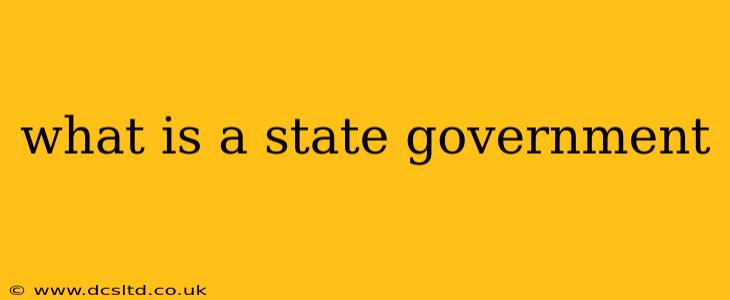State governments are a crucial part of the United States' federal system, sharing power with the federal government and local governments. Understanding their structure, functions, and responsibilities is key to comprehending how the US political system operates. This comprehensive guide will explore what a state government is, its key components, and its role in the lives of American citizens.
What are the key functions of state governments?
State governments possess a wide range of responsibilities, impacting nearly every aspect of daily life. Their primary functions include:
-
Public Education: State governments are largely responsible for establishing and funding public education systems, setting curriculum standards, and overseeing teacher licensing. This involves significant budgeting and policy-making related to K-12 education and, in some states, higher education as well.
-
Public Health and Welfare: State governments play a critical role in ensuring public health through initiatives like disease control, sanitation regulations, and managing public health crises. They also administer welfare programs, providing assistance to those in need.
-
Transportation: State governments oversee the construction, maintenance, and operation of major roadways, highways, and public transportation systems within their borders. They also regulate traffic and transportation safety.
-
Public Safety: State governments are responsible for establishing state police forces, overseeing correctional facilities, and contributing to the overall safety and security of their citizens. This also includes developing and implementing policies related to crime and justice.
-
Environmental Protection: State governments often have their own environmental protection agencies that enforce environmental regulations, manage natural resources, and protect wildlife within their state's boundaries.
How is a state government structured?
Most state governments mirror the federal government's structure, employing a system of checks and balances among three branches:
-
Executive Branch: Headed by the Governor, the executive branch enforces state laws and manages the day-to-day operations of state government. This includes various departments and agencies responsible for implementing policies in areas such as education, health, transportation, and public safety.
-
Legislative Branch: Composed of a bicameral legislature (a Senate and a House of Representatives, although the names may vary slightly from state to state), this branch is responsible for creating state laws. The legislature also approves the state budget and oversees the executive branch.
-
Judicial Branch: The judicial branch interprets state laws and ensures they are applied fairly. This branch consists of state courts, including trial courts, appellate courts, and a state supreme court.
What powers do state governments have?
State governments possess significant powers derived from the Tenth Amendment to the US Constitution, which reserves powers not delegated to the federal government to the states or the people. These powers include:
-
Police Powers: States have the authority to regulate the health, safety, and welfare of their citizens within their borders. This includes the power to enact laws related to criminal justice, public health, and environmental protection.
-
Taxation: States have the power to levy taxes on individuals and businesses within their borders to fund state programs and services.
-
Regulation of Intrastate Commerce: States can regulate commerce that occurs entirely within their borders.
-
Property Law: States have authority over matters related to property ownership, including real estate, personal property, and inheritance.
What is the difference between a state government and a federal government?
The key difference lies in their jurisdiction and the scope of their power. The federal government has authority over matters of national concern, such as national defense, foreign policy, and interstate commerce. State governments, on the other hand, primarily handle matters affecting their citizens within their geographical boundaries. The relationship is one of shared power, with some areas of overlapping jurisdiction, requiring cooperation and coordination between federal and state agencies.
How are state governments funded?
State governments receive funding from various sources, including:
-
Taxes: State taxes, including income tax, sales tax, and property tax, constitute a major portion of state revenue.
-
Federal Grants: The federal government provides grants to states for specific programs and initiatives.
-
Fees and Licenses: Revenue is also generated through various fees and licenses, such as driver's licenses and business permits.
-
Other Revenue Sources: States may also receive revenue from sources like lotteries and state-owned assets.
How can I get involved in my state government?
Citizens can actively participate in their state government through several avenues:
-
Voting: Participating in elections at the state level is fundamental to shaping the direction of state policies.
-
Contacting Elected Officials: Reach out to your state representatives and senators to share your views on important issues.
-
Attending Public Meetings: Attend meetings of state legislative committees and other government bodies to observe the legislative process and provide input.
-
Joining Advocacy Groups: Engage with organizations that advocate for specific issues or policies at the state level.
Understanding the intricacies of state governments is crucial for informed civic engagement. By being aware of their structure, functions, and responsibilities, citizens can become more effective advocates for their communities and contribute to the democratic process.
